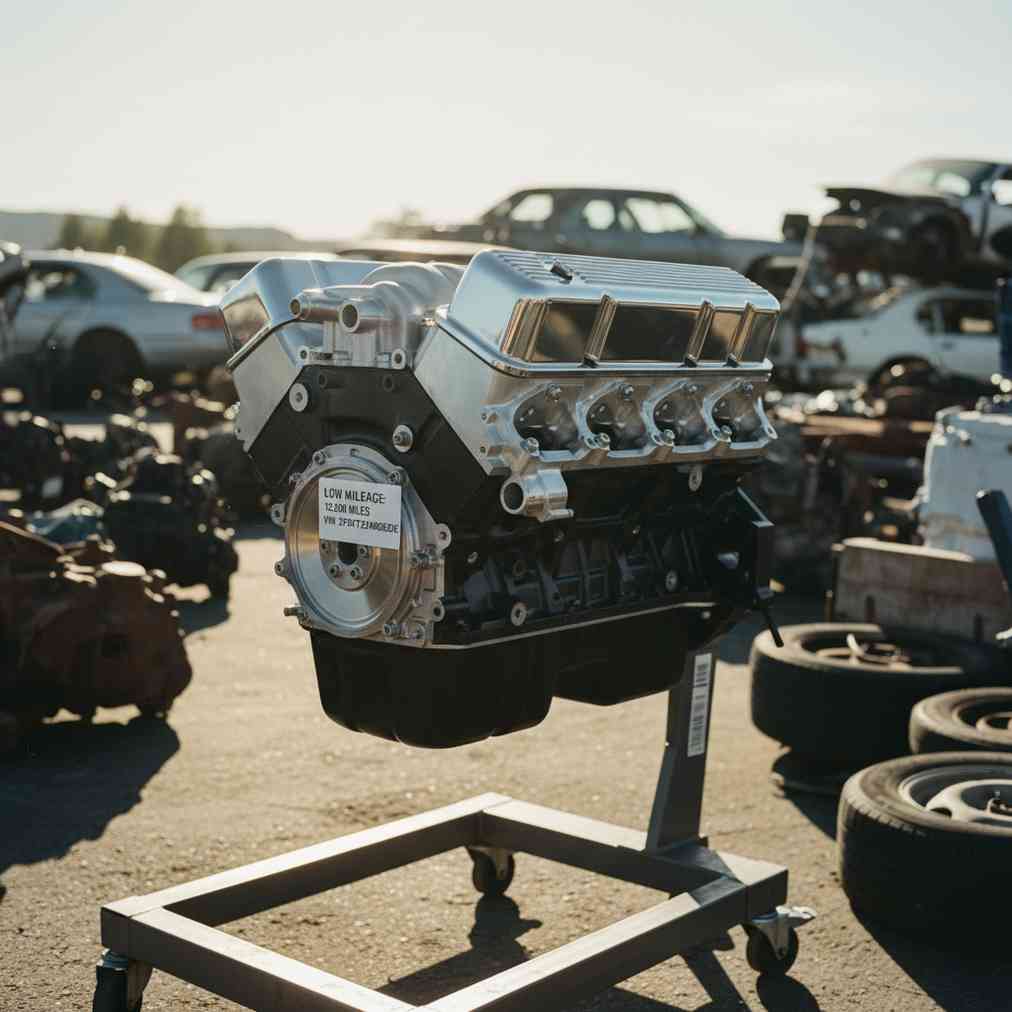Understanding the Balance: Mileage vs. Condition in Salvage Engines
When searching for a salvage engine, understanding the relationship between mileage and condition is crucial for making a smart purchase. While many buyers focus solely on low mileage numbers, the actual condition of the engine often tells a more complete story about its reliability and remaining lifespan.
Finding the right salvage engine requires balancing two critical factors: numerical mileage expectations and real-world condition indicators. An engine with 100,000 miles but excellent maintenance records can often outperform a 50,000-mile engine that was severely neglected or improperly stored.
Key Insights for Sourcing Quality Salvage Engines
When sourcing a salvage engine, you’re essentially looking for the best value combination of low upfront cost and long-term reliability. Here are the most important factors to consider:
- Mileage Guidelines: Look for engines with less than 75,000 miles when possible, as this reduces the likelihood of significant wear. An ideal engine averages around 15,000 miles per year of use
- Condition Trumps Numbers: A high-mileage engine with documented oil changes and proper maintenance often proves more reliable than a low-mileage engine from a neglected vehicle
- Source Reputation: Reputable salvage yards that inspect and warranty their engines provide significantly more security than private sellers
- Warranty Protection: Never buy a used engine without some form of warranty or return policy – this indicates the seller’s confidence in the product quality
For those looking to find quality salvage engines, our comprehensive junkyard database can help locate reputable salvage yards near you with verified inventory and customer reviews.
Major Benefits of Choosing Salvage Engines
Opting for salvage engines offers compelling advantages that make them an attractive choice for cost-conscious vehicle repairs and restorations:
| Benefit | Details | Potential Savings |
|---|---|---|
| Cost Savings | Used engines cost significantly less than new or rebuilt options | 50-70% savings |
| Environmental Impact | Reduces manufacturing demand and landfill waste | Sustainability benefits |
| Availability | Access to older or rare engines no longer in production | Immediate availability |
| Proven Performance | OEM parts with road-tested reliability | Quality assurance |
These cost savings make salvage engines particularly valuable for older vehicles where the repair cost might otherwise exceed the vehicle’s value. Understanding when to buy used auto parts can help you make informed decisions about engine replacement timing.
Comprehensive Salvage Engine Inspection Checklist
A thorough inspection process is essential for evaluating a salvage engine’s true condition, regardless of stated mileage. Use this systematic approach:
Documentation and History Verification
- Service Records: Request maintenance history, oil change records, and any major repair documentation
- Vehicle History: Obtain Carfax or similar reports to identify accident history, especially front-end collisions
- Mileage Verification: Cross-reference odometer readings with service records and vehicle history
- Usage Pattern: Understand whether the vehicle was used primarily for highway or city driving
Visual and Physical Inspection
| Inspection Area | What to Check | Red Flags |
|---|---|---|
| Engine Block | Look for cracks, deep corrosion, or rust | Visible cracks, deep pitting, recent cleaning to hide leaks |
| Gasket Surfaces | Check head gasket areas for oil leaks | Oil seepage, warped surfaces, milky residue |
| External Components | Inspect belts, hoses, and mounting brackets | Cracked hoses, frayed belts, damaged mounts |
| Fluid Levels | Check oil and coolant color and consistency | Dark/burnt oil, metal shavings, low fluid levels |
Mechanical Testing Procedures
The most critical aspect of salvage engine evaluation involves hands-on mechanical testing:
- Manual Rotation Test: Turn the crankshaft pulley by hand to ensure smooth rotation without binding or unusual resistance
- Compression Testing: Perform compression tests on all cylinders – readings should be within 5-10% of each other
- Leak-Down Test: A pressure loss up to 10% may be acceptable for used engines, compared to 5% for new engines
- Oil Analysis: Examine oil under the filler cap for signs of contamination, sludge, or metal particles
“The most important thing when buying a used engine is to make sure the compression is similar across the board. More than a 10-percent variance could indicate serious internal issues that may not be immediately apparent.”
– Engine Rebuilding Expert
Calculating Expected Lifespan and Value
Understanding the remaining useful life of a salvage engine helps justify the investment and plan for future maintenance:
- Average Lifespan: Quality salvage engines typically provide 75,000 to 100,000 additional miles of service
- Lifespan Calculation: Subtract current mileage from expected total lifespan (often 200,000+ miles), then divide by annual driving habits
- Cost Per Mile: Calculate the engine cost divided by expected remaining miles to compare value against other options
This calculation becomes especially important when considering whether engine replacement makes financial sense compared to selling your vehicle for cash and purchasing a different one.
Modern Trends in Salvage Engine Sourcing
The salvage engine market has evolved significantly with technological advances and changing consumer preferences:
Online vs. Traditional Salvage Yards
| Source Type | Advantages | Considerations |
|---|---|---|
| Online Retailers | Warranties, tested engines, direct shipping to mechanics | Higher initial cost, limited physical inspection |
| Local Salvage Yards | Lower prices, personal inspection, immediate pickup | Limited warranties, “as-is” condition, self-removal required |
| Specialized Networks | Rigorous testing, standardized warranties, quality assurance | Premium pricing, limited local availability |
Quality Assurance Improvements
Modern salvage operations increasingly offer:
- Professional Testing: Comprehensive compression and leak-down testing before sale
- Digital Documentation: Photo documentation of engine condition and test results
- Extended Warranties: 30-90 day warranties becoming standard from reputable sellers
- Installation Support: Technical assistance and compatibility verification services
Expert Recommendations for Salvage Engine Success
Industry professionals consistently emphasize these critical success factors:
- Professional Installation: Even the best salvage engine requires proper installation by qualified mechanics
- Supporting Systems: Replace belts, hoses, and filters during installation to prevent premature failure
- Break-in Period: Follow manufacturer recommendations for initial operation to ensure optimal performance
- Documentation: Keep all paperwork including warranties, test results, and installation records
For additional insights on evaluating used automotive components, explore our guide on OEM parts quality and junkyard availability.
Common Mistakes to Avoid
Learning from others’ experiences can prevent costly mistakes in salvage engine purchases:
| Mistake | Consequence | Prevention |
|---|---|---|
| Focusing Only on Mileage | Overlooking maintenance history and actual condition | Equal weight to condition indicators and documentation |
| Skipping Compression Testing | Missing internal wear or damage | Always test compression before purchase |
| Buying Without Warranty | No recourse for hidden problems | Only purchase from sellers offering guarantees |
| Ignoring Compatibility | Engine won’t fit or function properly | Verify exact model and engine code matches |
Making the Final Decision
Successfully finding a salvage engine by mileage and condition requires a balanced approach that weighs multiple factors beyond simple odometer readings. The best salvage engines combine reasonable mileage with documented maintenance history, verified mechanical condition, and purchase from reputable sources with appropriate warranties.
Remember that condition ultimately trumps mileage in determining long-term reliability. A well-maintained engine with higher mileage often provides better value and performance than a neglected low-mileage alternative. By following the comprehensive inspection checklist and working with reputable suppliers, you can find a salvage engine that delivers reliable service for years to come.
Whether you’re restoring a classic vehicle, repairing a daily driver, or building a project car, the right salvage engine can provide an economical and environmentally responsible solution when chosen with careful attention to both mileage and condition indicators.





Leave a Reply
You must be logged in to post a comment.